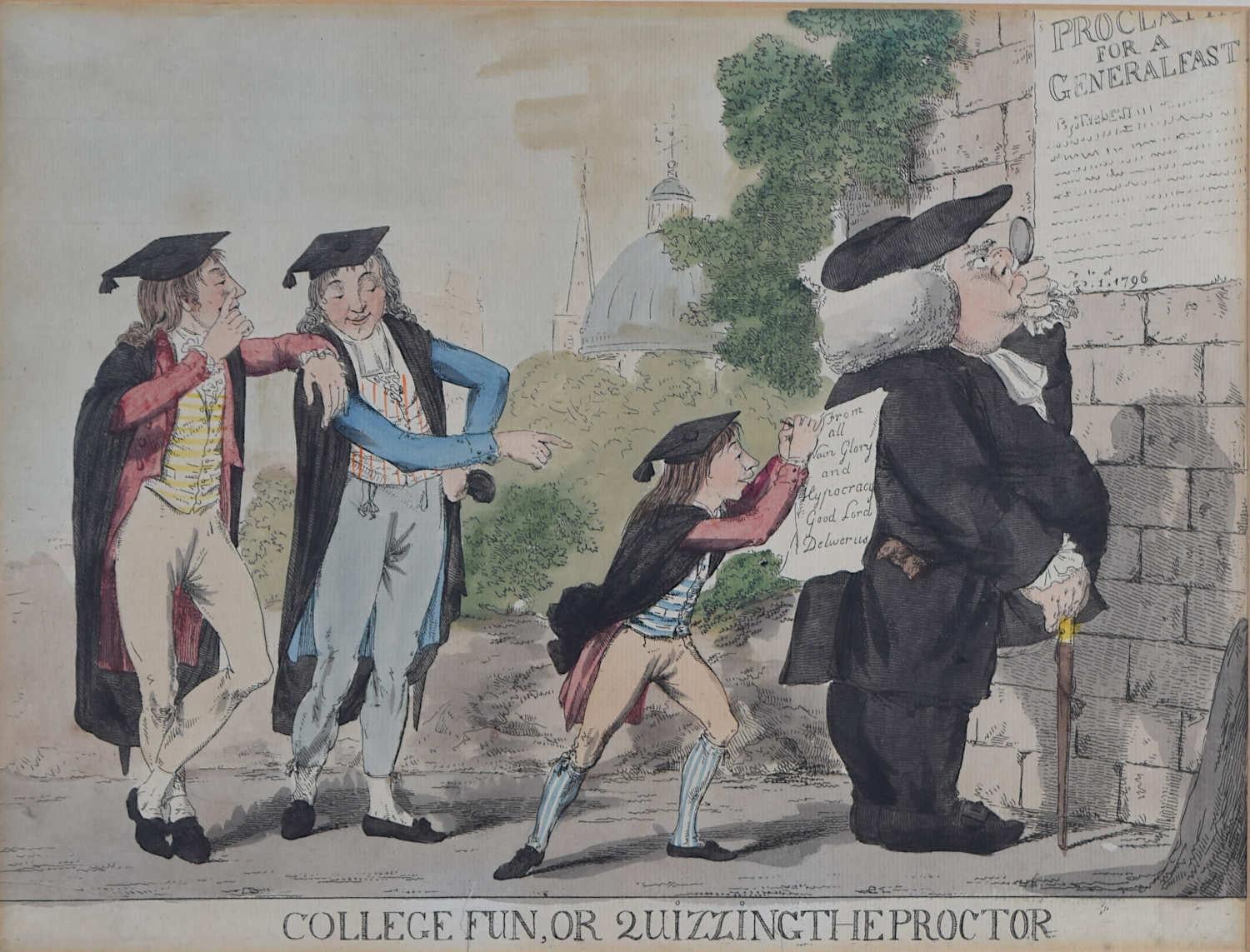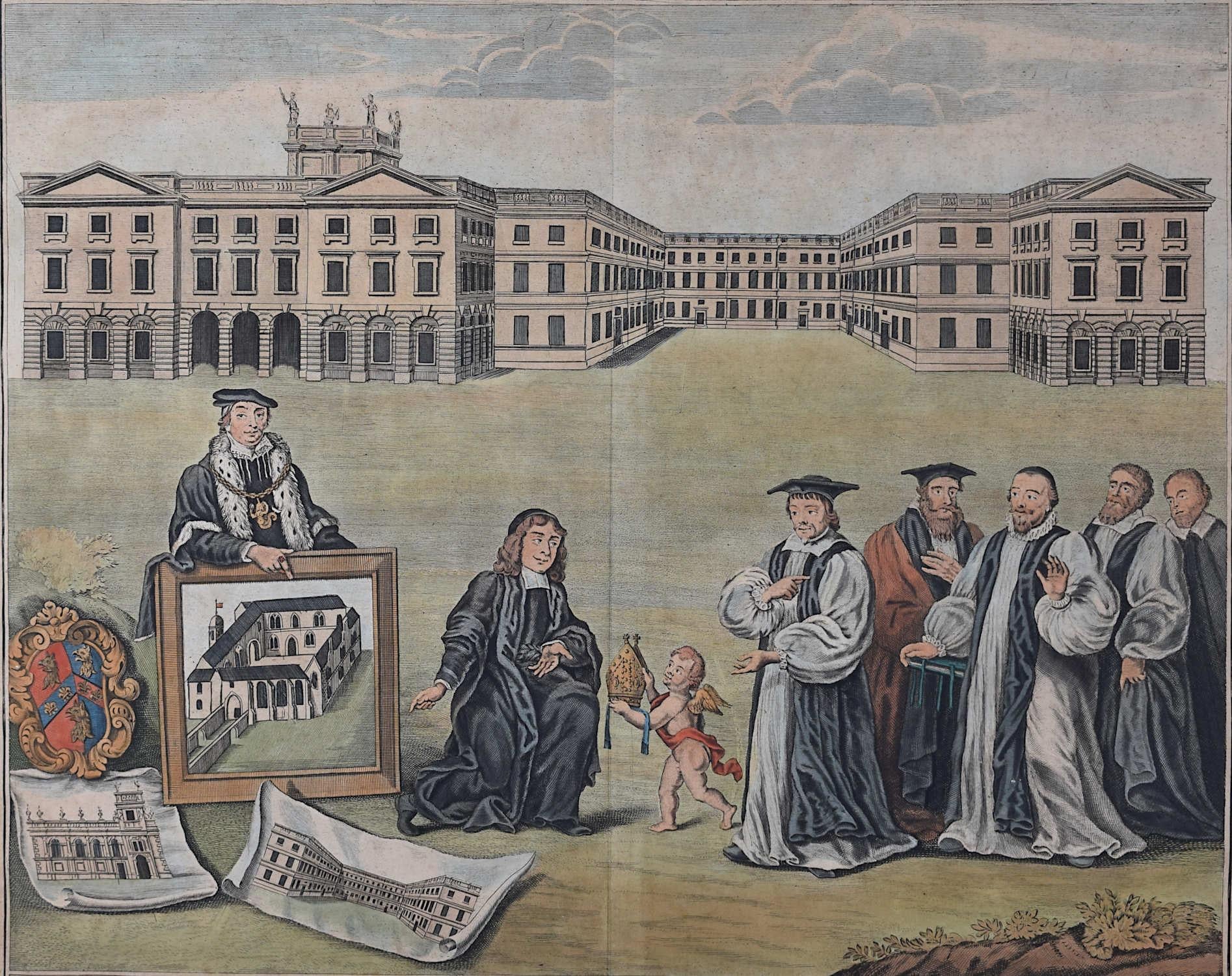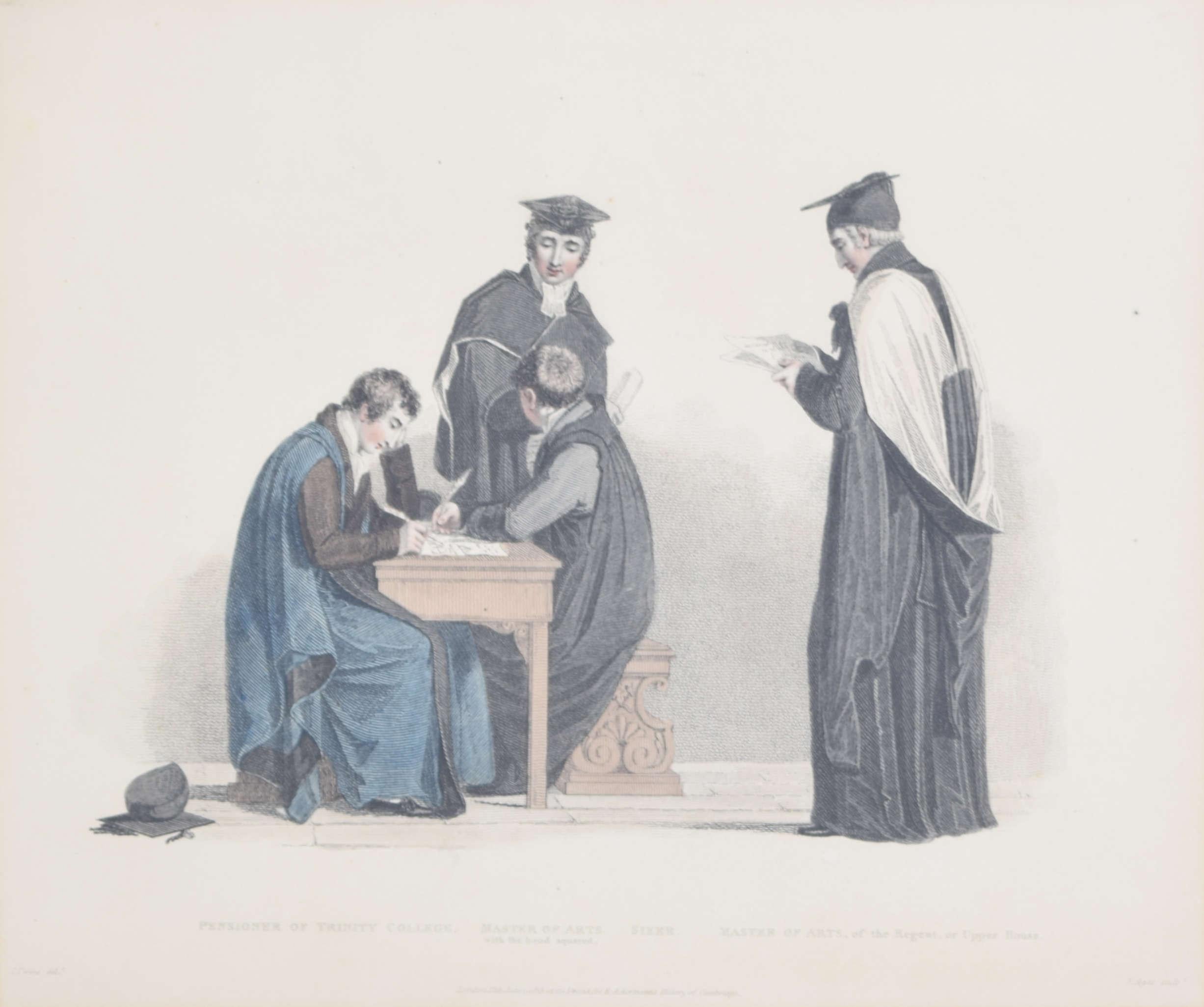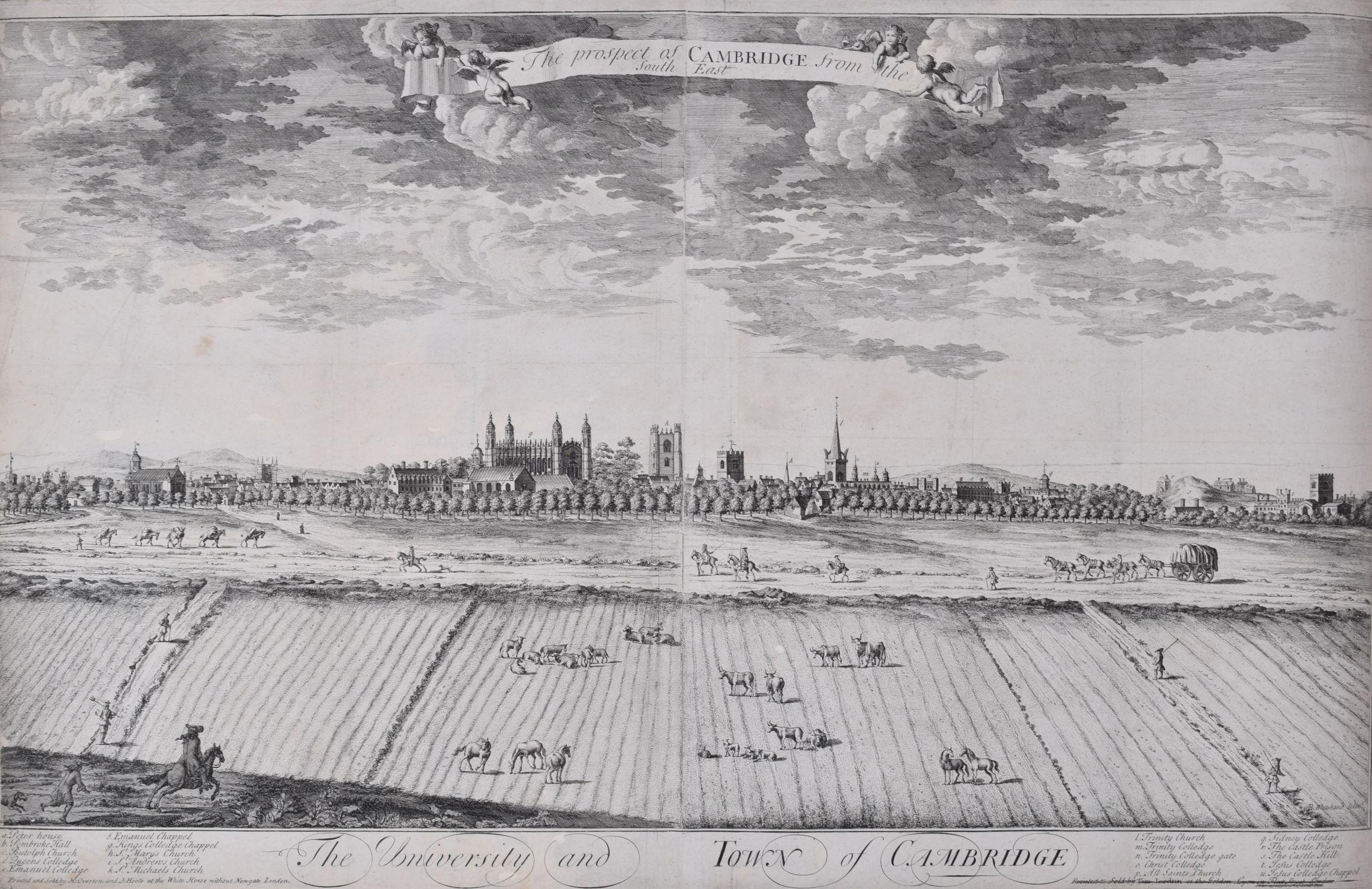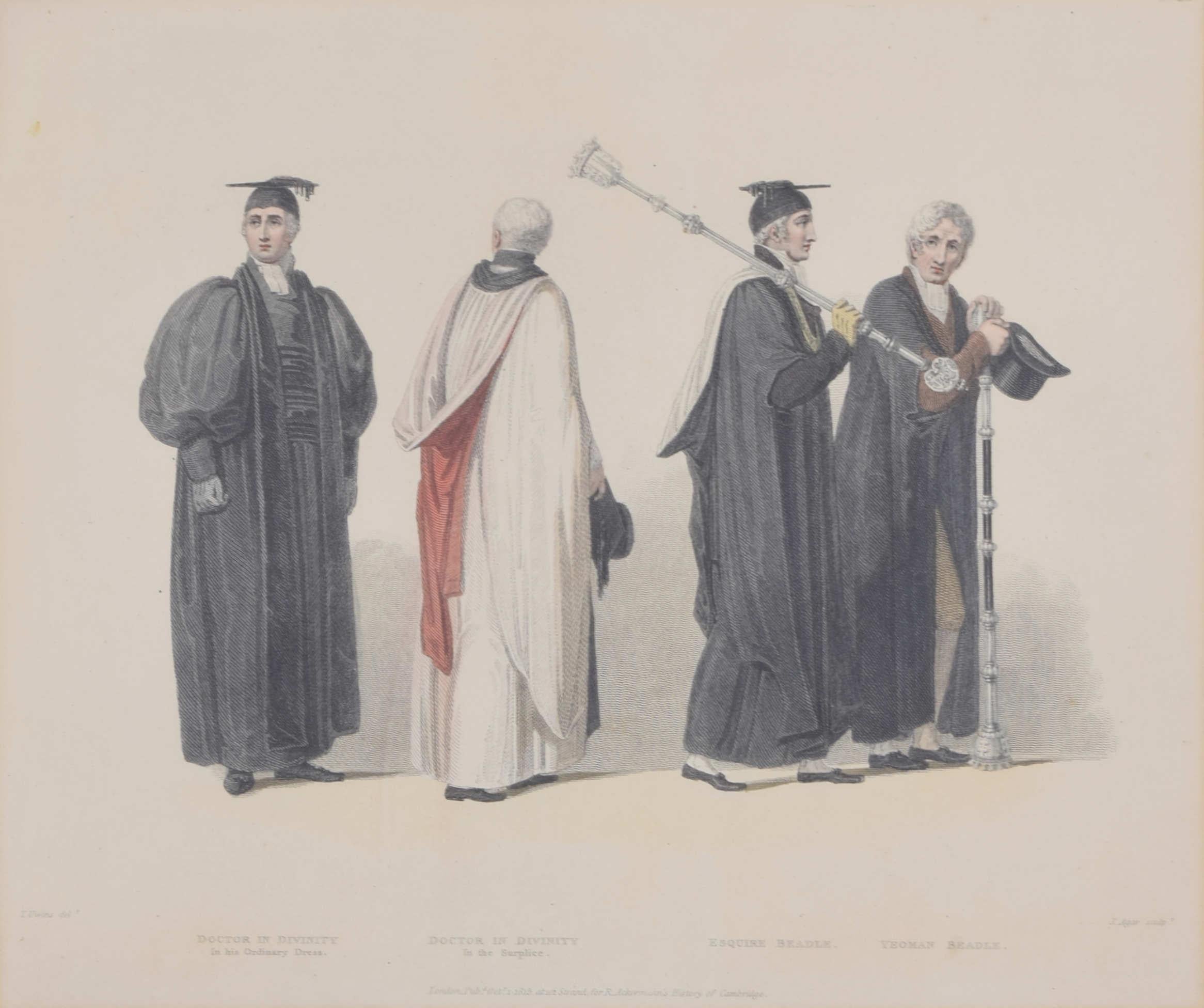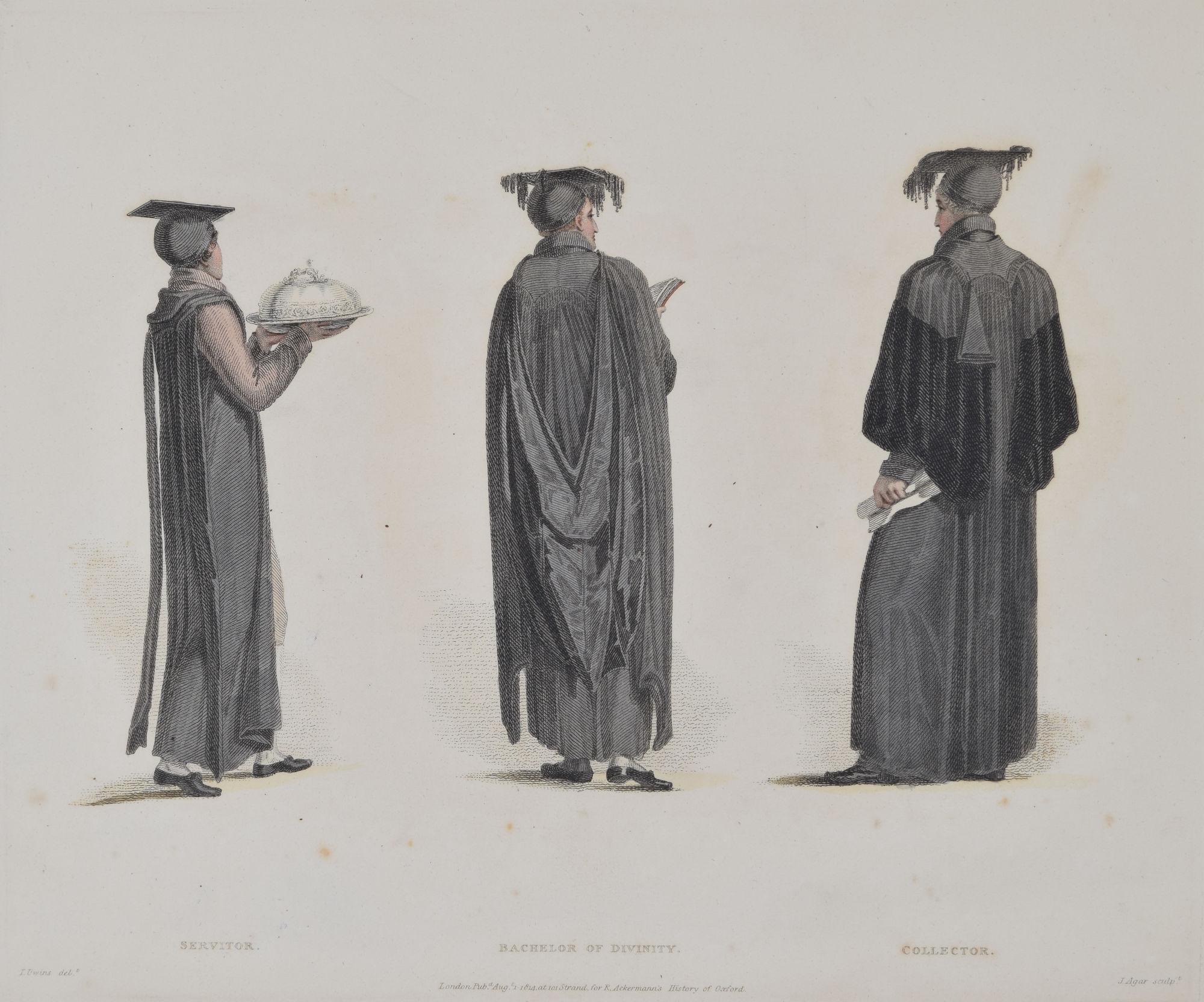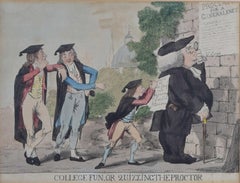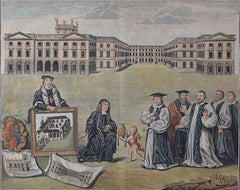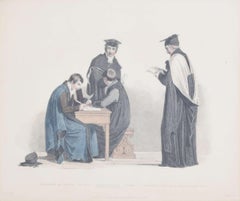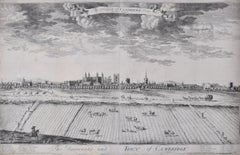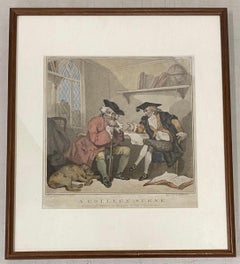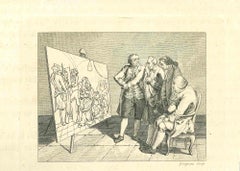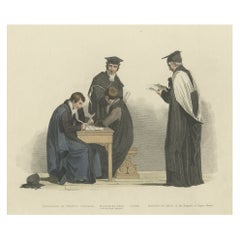Items Similar to The Hopes of the Family, University of Cambridge engraving by William Bunbury
Want more images or videos?
Request additional images or videos from the seller
1 of 9
William Bunbury The Hopes of the Family, University of Cambridge engraving by William Bunburyc.1790
c.1790
$378.10
£280
€326.24
CA$530.70
A$578.83
CHF 304.34
MX$6,946.22
NOK 3,842.67
SEK 3,584.16
DKK 2,436.57
About the Item
William Bunbury, engraved by James Bretherton
The Hopes of the Family
Hand coloured engraving
26 x 36 cm
c.1790
This engraving, titled "The Hopes of the Family – An Admission at the University", is satirical work by William Bunbury. The scene portrays a young man being presented for admission to the University of Cambridge. Although the title suggests that the boy is expected to achieve great things, his appearance and and general demeanour hint at incompetence or lack of enthusiasm, thus introducing an ironic paradox.
This caricatural scene dates from the late 18th century, a period when William Bunbury, alongside James Gillray, Thomas Rowlandson, and Isaac Cruikshank, was producing humorous and often politically charged works. Their engravings frequently lampooned figures of authority, including politicians, clergy, and university officials. This engraving is therefore illustrative of its time, clearly representing broader trends in the unique convergence between art and politics.
William Bunbury was an English caricaturist and illustrator known for his humorous depictions of 18th-century social life. Born in 1750 into an aristocratic family, he studied at St. Catharine’s College, Cambridge, where he developed a passion for art. Unlike many professional artists of his time, Bunbury was a gentleman amateur, meaning he pursued art for personal enjoyment rather than financial necessity.
Though not as politically charged as contemporaries like James Gillray or Thomas Rowlandson, Bunbury’s style was more lighthearted and observational. His illustrations of rural life, student antics, and military themes were especially popular, influencing later British caricature. Although he passed away in 1811, he left a legacy of caricatures that wittily captured the unique humour and manners of Georgian England.
- Creator:William Bunbury (1750 - 1811, British)
- Creation Year:c.1790
- Dimensions:Height: 10.24 in (26 cm)Width: 13.78 in (35 cm)
- Medium:
- Movement & Style:
- Period:1790-1799
- Framing:Framing Options Available
- Condition:Generally very good, some age toning.
- Gallery Location:London, GB
- Reference Number:1stDibs: LU795316076502
About the Seller
4.8
Vetted Professional Seller
Every seller passes strict standards for authenticity and reliability
Established in 2014
1stDibs seller since 2017
361 sales on 1stDibs
Typical response time: 13 hours
- ShippingRetrieving quote...Shipping from: London, United Kingdom
- Return Policy
More From This Seller
View AllCollege Fun at the University of Cambridge, engraving by William Bunbury
Located in London, GB
William Bunbury, engraved by James Bretherton
College Fun or Quizzing the Proctor
Hand coloured engraving
27 x 34 cm
c.1790
In this playful scene, a proctor--garnering a powdered wig and academic dress--is reading a public proclamation regarding a 'general fast.' Unbeknownst to him, a mischievous student is pinning a satirical note on his back. The note mocks the proctor's authority, reading, "From all Pride, Vanity, Glory and Hypocrisy, Good Lord Deliver us." Meanwhile, two other students, dressed in academic gowns and mortarboards, stand to the left, laughing and gesturing at the proctor, clearly enjoying the other student's prank.
This caricatural scene dates from the late 18th century, a period when William Bunbury, alongside James Gillray, Thomas Rowlandson, and Isaac Cruikshank...
Category
1790s Realist Figurative Prints
Materials
Engraving
The Founder and Benefactors of Trinity College, Oxford, 18th Century engraving
Located in London, GB
To see our other views of Oxford and Cambridge , particularly suitable for wedding and graduation presents, scroll down to "More from this Seller" and below it click on "See all from...
Category
18th Century Other Art Style Figurative Prints
Materials
Engraving
MA Masters of Arts and Trinity College, Cambridge member engraving by John Agar
Located in London, GB
To see our other Oxford and Cambridge pictures, including an extensive collection of works by Ackermann, scroll down to "More from this Seller" and below it click on "See all from this Seller" - or send us a message if you cannot find the view you want.
John Samuel Agar (1773 - 1858) after John Uwins (1782 - 1857)
Pensioner of Trinity College, Cambridge, Masters of Arts, and Sizer (1815)
Hand-coloured aquatint
25 x 30 cm
Published by Rudolph Ackermann (1764 - 1834).
An engraving of a pensioner of Trinity College, Masters of Arts, and a sizer (that is, an undergraduate who received some form of assistance such as meals, lower fees or lodging during his period of study, in some cases in return for doing a defined job) from Ackermann's 'A History of the University of Cambridge, Its Colleges, Halls and Public Buildings'. The four figures walk forward with ceremonial accoutrements, possibly to a graduation ceremony.
At Cambridge, a sizar was originally an undergraduate student who financed his studies by undertaking more or less menial tasks within his college but, as time went on, was increasingly likely to receive small grants from the college. Certain colleges, including St John's and Trinity, distinguished between two categories of sizar: there were specific endowments for specific numbers of sizars who were called "proper sizars"; those who were not so endowed, but who were maintained by fellow-commoners and fellows were called subsizars. Isaac Newton matriculated as subsizar at Trinity College. Richard S. Westfall noted that sizars were considerably more successful in gaining degrees than the gentlemen who entered Cambridge in the seventeenth century. Pensioners, on the other hand, paid a fixed annual fee in order to study.
Thomas Uwins RA RWS was a British painter in watercolour and oil, and a book illustrator. He became a full member of the Old Watercolour Society and a Royal Academician, and held a number of high-profile art appointments including the librarian of the Royal Academy, Surveyor of Pictures to Queen Victoria and the Keeper of the National Gallery. In the late 1790s he began producing work for Ackermann's collections.
John Samuel Agar was an English portrait painter and engraver, who exhibited his works at the Royal Academy from 1796 to 1806 and at the British Institution until 1811. He was at one time president of the Society of Engravers. Rudolph Ackermann published many of his engravings.
Ackermann was an Anglo-German bookseller, inventor, lithographer, publisher and businessman. He attended the Latin school in Stollberg, but his wish to study at the university was made impossible by lack of financial means, and he therefore became a saddler like his father.
He worked as a saddler and coach-builder in different German cities, moved from Dresden to Basel and Paris, and then, 23 years old, settled in London. He established himself in Long Acre, the centre of coach-making in London and close to the market at Covent Garden.
Ackermann then moved to Little Russell Street where he published Imitations of Drawings of Fashionable Carriages (1791) to promote his coach-making. Other publications followed. In 1795 he established a print-shop and drawing-school at 96 Strand. Here Ackermann set up a lithographic press and began a trade in prints. He later began to manufacture colours and thick carton paper for landscape and miniature painters. Within three years the premises had become too small and he moved to 101 Strand, in his own words "four doors nearer to Somerset House", the seat of the Royal Academy of Arts.
Between 1797 and 1800 Ackermann rapidly developed his print and book publishing business, encompassing many different genres including topography, caricature, portraits, transparencies and decorative prints.
During the Napoleonic wars, Ackermann was an energetic supporter of the Allied cause and made significant contributions to British propaganda through his publication of anti-Napoleonic prints...
Category
1810s Prints and Multiples
Materials
Aquatint
Cambridge University 18th century engraving by Jan Kip after Whitehand
Located in London, GB
To see our other views of Oxford and Cambridge, scroll down to "More from this Seller" and below it click on "See all from this Seller" - or send us a message if you cannot find the ...
Category
18th Century Realist Landscape Prints
Materials
Engraving
Doctors of Divinity, University of Cambridge 19th century engraving by John Agar
Located in London, GB
To see our other Oxford and Cambridge pictures, including an extensive collection of works by Ackermann, scroll down to "More from this Seller" and below it click on "See all from this Seller" - or send us a message if you cannot find the view you want.
John Samuel Agar (1773 - 1858) after John Uwins (1782 - 1857)
Doctors in Divinity, Esquire Beadle, and Yeoman Beadle (1815)
Hand-coloured aquatint
25 x 30 cm
Published by Rudolph Ackermann (1764 - 1834).
An engraving of two Doctors in Divinity and two beadles (administrative assistants to the Chancellor and Proctors of the University) from Ackermann's 'A History of the University of Cambridge, Its Colleges, Halls and Public Buildings'. The four figures walk forward with ceremonial accoutrements, likely to a graduation ceremony.
Thomas Uwins RA RWS was a British painter in watercolour and oil, and a book illustrator. He became a full member of the Old Watercolour Society and a Royal Academician, and held a number of high-profile art appointments including the librarian of the Royal Academy, Surveyor of Pictures to Queen Victoria and the Keeper of the National Gallery. In the late 1790s he began producing work for Ackermann's collections.
John Samuel Agar was an English portrait painter and engraver, who exhibited his works at the Royal Academy from 1796 to 1806 and at the British Institution until 1811. He was at one time president of the Society of Engravers. Rudolph Ackermann published many of his engravings.
Ackermann was an Anglo-German bookseller, inventor, lithographer, publisher and businessman. He attended the Latin school in Stollberg, but his wish to study at the university was made impossible by lack of financial means, and he therefore became a saddler like his father.
He worked as a saddler and coach-builder in different German cities, moved from Dresden to Basel and Paris, and then, 23 years old, settled in London. He established himself in Long Acre, the centre of coach-making in London and close to the market at Covent Garden.
Ackermann then moved to Little Russell Street where he published Imitations of Drawings of Fashionable Carriages (1791) to promote his coach-making. Other publications followed. In 1795 he established a print-shop and drawing-school at 96 Strand. Here Ackermann set up a lithographic press and began a trade in prints. He later began to manufacture colours and thick carton paper for landscape and miniature painters. Within three years the premises had become too small and he moved to 101 Strand, in his own words "four doors nearer to Somerset House", the seat of the Royal Academy of Arts.
Between 1797 and 1800 Ackermann rapidly developed his print and book publishing business, encompassing many different genres including topography, caricature, portraits, transparencies and decorative prints.
During the Napoleonic wars, Ackermann was an energetic supporter of the Allied cause and made significant contributions to British propaganda through his publication of anti-Napoleonic prints...
Category
1810s Prints and Multiples
Materials
Aquatint
University of Oxford Bachelor engraving by Agar after Uwins for Ackermann
Located in London, GB
To see our other Oxford and Cambridge pictures, including an extensive collection of works by Ackermann, scroll down to "More from this Seller" and below it click on "See all from this Seller" - or send us a message if you cannot find the view you want.
John Samuel Agar (1773 - 1858) after John Uwins (1782 - 1857)
Servitor, Bachelor of Divinity, Collector (1814)
Aquatint with original hand colouring
24 x 29 cm
Published by Rudolph Ackermann (1764 - 1834).
A Servitor; Bachelor of Divinity; and Collector of the University of Oxford.
Thomas Uwins RA RWS was a British painter in watercolour and oil, and a book illustrator. He became a full member of the Old Watercolour Society and a Royal Academician, and held a number of high-profile art appointments including the librarian of the Royal Academy, Surveyor of Pictures to Queen Victoria and the Keeper of the National Gallery. In the late 1790s he began producing work for Ackermann's collections.
John Samuel Agar was an English portrait painter and engraver, who exhibited his works at the Royal Academy from 1796 to 1806 and at the British Institution until 1811. He was at one time president of the Society of Engravers. Rudolph Ackermann published many of his engravings.
Ackermann was an Anglo-German bookseller, inventor, lithographer, publisher and businessman. He attended the Latin school in Stollberg, but his wish to study at the university was made impossible by lack of financial means, and he therefore became a saddler like his father.
He worked as a saddler and coach-builder in different German cities, moved from Dresden to Basel and Paris, and then, 23 years old, settled in London. He established himself in Long Acre, the centre of coach-making in London and close to the market at Covent Garden.
Ackermann then moved to Little Russell Street where he published Imitations of Drawings of Fashionable Carriages (1791) to promote his coach-making. Other publications followed. In 1795 he established a print-shop and drawing-school at 96 Strand. Here Ackermann set up a lithographic press and began a trade in prints. He later began to manufacture colours and thick carton paper for landscape and miniature painters. Within three years the premises had become too small and he moved to 101 Strand, in his own words "four doors nearer to Somerset House", the seat of the Royal Academy of Arts.
Between 1797 and 1800 Ackermann rapidly developed his print and book publishing business, encompassing many different genres including topography, caricature, portraits, transparencies and decorative prints.
During the Napoleonic wars, Ackermann was an energetic supporter of the Allied cause and made significant contributions to British propaganda through his publication of anti-Napoleonic prints...
Category
1810s Prints and Multiples
Materials
Aquatint
You May Also Like
Edward Williams "A College Scene" After Thomas Rowlandson Color Engraving C.1787
By Thomas Rowlandson
Located in San Francisco, CA
Edward Williams "A College Scene" After Thomas Rowlandson Color Engraving C.1787
Late 18th century hand colored engraving after Thomas Rowlandson
A scene of a young student asking ...
Category
Late 18th Century Figurative Prints
Materials
Engraving
The Physiognomy -The Painting - Original Etching by Thomas Holloway - 1810
By Thomas Holloway
Located in Roma, IT
The Physiognomy -The painting is an original etching artwork realized by Thomas Holloway for Johann Caspar Lavater's "Essays on Physiognomy, Designed to Promote the Knowledge and the...
Category
1810s Modern Figurative Prints
Materials
Etching
Nice Antique Print of a Master in Arts and Academics of Trinity College, 1815
Located in Langweer, NL
Antique print titled 'Pensioner of Trinity College - Master of Arts - Sizer - Master of Arts, of the regent, or Upper House'. Portraits of four men in academic costumes; a college ca...
Category
Antique 19th Century English Prints
Materials
Paper
$340 Sale Price
20% Off
Old Print of Nobleman and Fellow-Commoners of Trinity and Emanuel College, 1815
By Ackermann and Fritze 1
Located in Langweer, NL
Antique print titled 'Fellow Commoner of Emanuel College - Nobleman - Fellow Commoner of Trinity College'. Portraits of a Fellow Commoner of Emanuel, Nobleman, and Fellow Commoner of...
Category
Antique 19th Century Prints
Materials
Paper
$340 Sale Price
20% Off
Historical Scene - Etching by Thomas Holloway - 1810
By Thomas Holloway
Located in Roma, IT
Historical scene is an artwork realized by Thomas Holloway for Johann Caspar Lavater's "Essays on Physiognomy, Designed to promote the Knowledge and the Love of Mankind", London, Be...
Category
1810s Modern Figurative Prints
Materials
Etching
William Hogarth . Original engravings 155 pсs., 1 piece with blend. 1822 London
By William Hogarth
Located in Riga, LV
William Hogarth (1697-1764)
Original engravings 155 pсs., 1 piece with blend. 1822 London
From A. Neibergs collection
Category
1820s Realist Figurative Prints
Materials
Paper, Engraving
